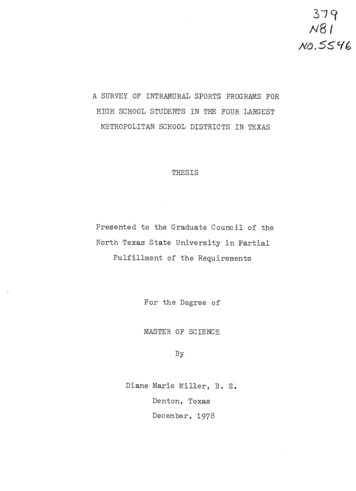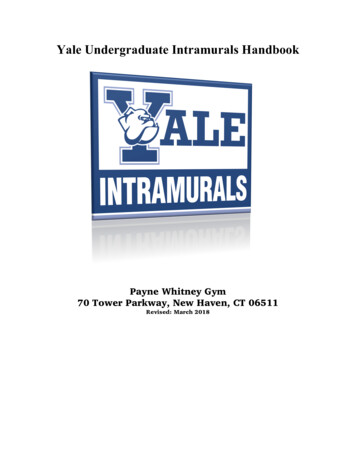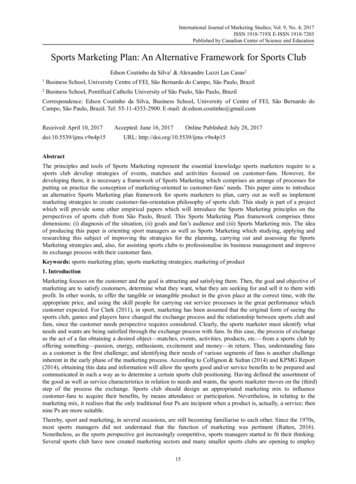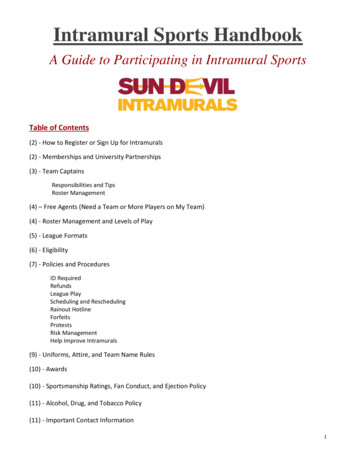
Transcription
NB,A SURVEY OF INTRAMURAL SPORTS PROGRAMS FORHIGH SCHOOL STUDENTSIN THE FOUR LARGESTMETROPOLITAN SCHOOL DISTRICTS IN TEXASTHESISPresented to the Graduate Council of theNorth Texas State University in PartialFulfillment of the RequirementsFor the Degree ofMASTER OF SCIENCEByDiane Marie Miller, B. S.Denton, TexasDecember, 1978
Miller, Diane M., A Survey of Intramural Sports Programsfor High School Students in the Four Largest MetropolitanSchool Districts in Texas.Administration).bibliography,Master of Science(RecreationDecember, 1978, 61 Pp., 9 tables,32 titles.The purposes of this study were to determine whetherintramural sports programs are available to senior highschool students in the four largest metropolitan schooldistricts in Texas and to determine reasons why schools maynot offer intramural programs.Questionnaires were mailed to eighty-four high schoolsin the Dallas, Fort Worth, Houston,Independent School Districts.and San AntonioData obtained from this surveyrevealed that a majority of the responding schools do notsponsor intramural sports programs for theirstudents.The factors cited most often as the reasons for notsponsoring intramural programs were lack of facilities,inadequate number of personnel,lack of transportation,conflict with interscholastic sports.and
TABLE OF CONTENTS.LIST OF TABLESPageiv.Chapter-- II.INTRODUCTION.a.-*Statement of ProblemPurposes of the StudyDefinition of TermsDelimitationsSignificance of the StudyII.e. . a. s. . . . - 17III.REVIEW OF THE LITERATURE.PROCEDURES.a. .a.7aDescription of SampleDevelopment of the InstrumentAnalysis of the DataIV.ANALYSIS OF THE DATA.a.21Findings of the StudyDiscussion of the FindingsSummaryV.AND RECOMMENDATIONSSUMMARY, CONCLUSIONS,4SummaryFindingsC onc lus ionsRec ommendat ionsAPPENDICESa a aBIBLIOGRAPHY.a.a a aa a.a aa a aiiia a a.aaa a a aaa-a-a a a a aaa aa46a58
LIST OF TABLESTablePageI.II.III.IV.Total School Enrollment .VII.VIII.22.Reasons Indicated for Not SponsoringIntramural Programs for Boys and Girls.24.26. .a.28Number of Boys and Girls Involved inIntramurals Based on Total School.Problems Encountered by Schools ConductingPrograms.*.a.Persons Serving as Director of IntramuralSports Programs.29Methods of Financing Intramural SportsPrograms. . . . . . . . . . . . . . . . . .31Activities Offered in the Intramural Programand the Number of Schools Offering ThemIX.23'IntramuralVI.Number of Schools Indicating Sponsorship orNon-Sponsorship of Intramural ProgramsBased on Total School Enrollment. . . . . .EnrollmentV.33.34Facilities Available for Intramural Programsand the Number of Schools Having Them . .iv
CHAPTER IINTRODUCTIONIntramural sports programs have been part of Americansociety for many years.Activities of this nature began incolleges and universities in the 1800's as indicated byMueller (6, p. 17) in his statement, "In 1859 at Yale,boating clubs competed intramurally and subsequently servedas the basis for interclass crews."Mueller (6, p. 18)further indicated that intramural activities appeared in thehigh schools around 1925 to 1930.Hyatt (2,p. 12) reportedthat intramural activities offer high school students opportunities to develop socially, mentally, emotionally, andphysically, as well as to acquire many lifetime sports andrecreational skills.Kleindienst and Weston (4, p. 33)stated that intramural activities should "bring refreshmentand satisfaction to the participant during his leisure hours."Many public school systems are offering intramural programs for their students.According to Beeman and Humphrey(1, p. 2), "At the present time intramural programs are becoming more firmly entrenched each year in the schools ofAmerica."It is not always possible,however,for allschools to provide these programs for a variety of reasons.One of these reasons is lack of qualifiedpersonnel.Mueller (6, p.leadership and37) stated that "The success of1
2intramurals can never rise above the quality of itsship."leader-He feels there is a lack of properly trainedintramural leadership in our publicschools.Many timesthe responsibility of administering the intramural programfalls on the physical education instructors or the coaches,and often they do not have the time or the background toconduct a good program.Mueller (6) also indicated thatspecific courses regarding the administration of intramuralsshould be offered for all physical education.majors incolleges.A second reason why schools have problems providingintramural programs is conflicts with interscholastic sportsin scheduling facilities and time periods for intramurals.Means (5, p. 75) indicated, "Time allotment looms large inthe administrative planning of an adequate intramuralrecreational program in every school, regardless of size."Hyatt (2, p. 59) pointed out that "The ideal time is afterschool hours, but conflicts with varsity sports often arise."Many times there are limited facilities available for sportsactivities and interscholasticsports receive firstpriority.Hyatt (2) further indicated that since intramural sportsprovide activities to a large number of students at all skilllevels, extra cooperation in scheduling is necessary betweenathletics and intramurals so that the largest number ofstudents can participate.Another reason schools find it difficult to provideintramural programs is insufficient funding.Hyatt
3(2, p. 247) stated, "The budget problem is a real one for themajority of directors,and the financial area receives agreat deal of time and interest from concerned administrators."According to Peterson (7, p. 202), "The most desirableapproach to financing a program is a specific allocation fromthe school board."This way the program director knowsexactly how much he or she has to operate with for the schoolyear.If a specific budget is not provided for intramurals,fund raising projects can sometimes help raise the neededmoney.Educators are interested in the present status of intramural programming in the public school systems.Means (5,p. vii) stated that "It has been heartening in recent yearsto observe that school administrators all over the nationare strengthening their demands to provide more wiselyplanned school recreation."Therefore, it is important atthis time to determine the extent of present intramural pro-grams being conducted in various school systems andprogramming problems that are being encountered.Statement of the ProblemThis study was designed to determine whether intramuralsports programs are available to senior high school studentsin the four largest metropolitan school districts in Texasand to determine reasons why schools may not offer intramuralprograms.
4Purposes of the StudyThe purposes of this study were as follows:1.To determine whether intramural sports programs areavailable to senior high school students in the four largestmetropolitan school districts in Texas;2.To determine reasons why schools may not offerintramural sports programs;3.To obtain information concerning specific programmingareas such as the number of students involved in intramurals,the number of hours per week programs are conducted,andproblems that are encountered by schools offering programs;4.To obtain information concerning program personnel,program financing,activities offered,and the availabilityof facilities in schools indicating that they do offer theseprograms.Definition of TermsThe following definitions were used in this study.1.Intramural Sports.--Intramural sports is defined assupervised team, individual or dual sport activities in whichstudents from the same school participate2.(3, p. 188).Four Largest Metropolitan School Districts in Texas(operational).--The four largest metropolitan school districtsin Texas are defined as school districts with an averagedaily attendance figure of 59,000or more students.Theseinclude the Dallas, Fort Worth, Houston, and San AntonioIndependent School Districts.
53.Physical Education Teacher (operational).--Physicaleducation teacher isdefined as an individual who teachesphysical activities included in the physical educationcurriculum at the school being heris de-fined as an individual who teaches any course included inthe respective school's curriculum,and coaches one or moresports at the school being surveyed.DelimitationsThe delimitations of this study were as follows.1.Only four school districts were selected from all ofthe school districts in Texas.2.This study was delimited to the senior high schoolsin the Dallas, Fort Worth,Houston,and San Antonio Inde-pendent School Districts.Significanceof the StudyThe data from this survey were used to determine thepresent status of intramural programming in the high schoolsresponding to the survey.This information may also be usedto determine ways in which personnel at a university couldhelp in continuing,improving,or providing for intramuralsports programming in secondary schools.Schools indicatingthat they successfully offer intramural programs could serveas models for schools that do not offer programs at the presenttime.In addition, information was obtained concerning theprofessional preparation of those who direct the intramuralsports programs.
CHAPTER BIBLIOGRAPHY1.Beeman, Harris F. and James H. Humphrey, Intramural Sports,A Text and Study Guide, Dubuque, Iowa, William C.Brown Company, 1960.2.Hyatt, Ronald W., Intramural Sports, Organization andAdministration, Saint Louis, Missouri, C. V. MosbyCompany, 1977.3.Jordan, Willie J., "A Study of Intramural Sports for Boysin Selected Georgia High Schools," UnpublishedMaster's Thesis, Springfield College, 1970.4.Kleindienst, Viola and Arthur Weston, Intramural andRecreation Programs for Schools and Colleges, NewYork, New York, Appleton-Century-Crofts, 1964.5.Their Organization andMeans, Louis E., Intramurals:Administration, 2nd Edition, Englewood Cliffs, NewJersey, Prentice-Hall, Inc., 1973.6.Mueller, Pat, Intramurals:Programming and Administration,Fourth Edition, New York, New York, The Ronald PressCompany, 1971.7.Peterson, James A., Intramural Administration, Theory andPractice, Englewood Cliffs, New Jersey, PrenticeHall, Inc., 1976.6
CHAPTER IIREVIEW OF THE LITERATUREA review of the literatureindicated that intramuralsports are becoming an integral part of many school systemsAccording to Murphy, et al.throughout the United States.(25),America is becoming a society of leisure time,andAmericans need to learn to use this leisure time constructively.They (25, p. 7) stated that "In large measure, theindividual'sself-concept is based upon, and reinforced by,the activities he pursues during his leisure."Anderson (2)indicated that for years intramurals have taken a back seatto interscholasticsports, but that this is all changing.Students would rather participate than watch, and a goodintramural program can fulfill this need for many students.Anderson further indicated that the time is right now forintramural sports to become an integral part of school programs.Historically,intramurals were participated in to havefun, with low level competition included.Voltmer, et al.(29, p. 1) stated that "American and Americans have thrivedon competition,the wholeand friendly competition is the backboneintramural program."They stressed, however,ofthatthis competition should be fun and enjoyable more than anything else.Means(22)indicated that campus groups at7
8various colleges began organizing this friendly competitioninto structured programs which grew in popularity.In regardto this, Beeman and Humphrey (3) stated that fraternities,since they are permanent in nature, began to take charge oforganizing and conducting intramurals at their colleges.Later on, the colleges began to organize actual intramuraldepartments with a director.Another area that provided for the growth of intramuralprograms according to Mueller and Mitchell (24)of war veterans to schools.was the returnThe veterans were anxious to con-tinue the organized sports competition they had taken part inAs was stated in the Navalduring their military service.Aviation Physical Training Manual (28),many aspects of themilitary sports program could be and were adapted to a peacetime intramural program.The large number of these veteransinterested in intramurals helped the college programs growconsiderably.General education in America today should include educational pursuits for the body as well as the mind.Kleindienst and Weston (17, p. 13) stated, "Recreation inschools and colleges,and recreation,has inherent educationaltransform the mental,itiesas found in the programs of intramuralsphysical,values which canemotional,and social qual-of an individual to approach more closely the ideal ofthe educated man."Accordingto Beeman and Humphrey(3),educational institutions are obligated to provide intramural
9activities which enrich student opportunities and experiences.Kidd, et al. (16) wrote a position paper for the PhysicalEducation Division of the American Alliance for Health,Physical Education and Recreation in which they recommendedintramural sports be provided for all students with competition as equal as possible.They further recommended thatfinancing for these programs and additional personnel shouldbe provided by local boards of education.Rokosz (27, p. 13)said, "The best and most consistent means of financing a program is through a standard budget, which utilizes funds fromfunds of the insti-student fees or the regular operatingtution."A report in 1955 by the American Association for Health,Physical Education,and Recreation (1,pp. 2-3)indicatedthat participation in intramurals contribute to student'sThese four areas arewell-being in four different areas."The development of an environment in which sound principlesof living function;.Theenrichmentof the individual's per-sonality; The contribution to improved health and safetystandards;and, The social gains made possible throughparticipation."Leavitt and Price (18)pointed out that the whole childgoes to school and is affected by allof his daily experi-ences both inside and outside class.They feel intramuralsincrease the individual's physical,social,and emotional
10growth.The student is free to participate voluntarily whichhelps him or her develop a positive attitude toward the pro-gram.Mitchell (23) also emphasized that sports seem to havea universal appeal to all ages, and school age children enjoyparticipating in intramural sports and engaging in friendlycompetition with their fellow students.Hyatt (14, p. 58)stated that, "The objective of an intramural program at thesenior high school level is to provide a wide variety ofactivities, so as to encourage mass participation in team andindividual sports."Mitchell further stated that rules havebeen modified in many sports to fit the intramural programso that more students can be involved in an activity.According to Bucher (5), the objectives of these intramural activities should include areas of health,social development and recreation.skill,Development in these fourareas is essential for the child's total well-being.ANational Intramural Sports Task Force (26) also set areas ofobjectives which are similar to Bucher's objectives.TheTask Force further indicated a need for qualified leadershipand good student workers.Matthews (21)offered some good ideas on ways that highschools can get some assistance in planning, promoting,administering their intramural programs.quiring allto takeandHe suggested re-physical education majors and minors in collegea complete course in intramural administration.He
11further suggested taking surveys to determine the needs ofthe high school intramural programs and placing studentteachers in the schools to help start new programs.Thus,there would be some trained personnel to deal with specificproblems.The number of students actually involved, the extent andtype of programming, facilities, and budgeting for intramuralprograms in schools are factors of interest to educators allacross the country.In further surveying the literature,studies pertaining to various aspects of intramural sportswere found.A study was done by Maas(19)pertaining to intramuralsports activities in Iowa high schools.Maas found that,overall, intramural sports programs have decreased over thepast sixteen years mainly due to conflict with interscholastic sports, lack of facilities, and lack of time.DeNike (8)also did a study of several aspects on intra-mural programming in high schools.He discovered that a vastmajority of the programs were conducted by the physical edu-cation department with physical education department funds,and that facilitieswere shared with physical education andathletics.Other studies by Cox (7)and Brient (4)indicated goodprograms were being offered to students whenever possible;however, facilities,budgeting, and conflicts with athleticswere again major problems encountered.Jordan (15)surveyed
12intramural sports programs for boys in Georgia high schoolsand basically found them adequate.Based on his findings, hemade some suggestions regarding having better prepared programdirectors,broader program content,and more and better facil-ities.Specifically in Texas, Hewatt (11) studied girls' intramural programs in selected Texas high schools.She found inher study that most schools did provide a program and thatboth team and individual sports were offered.She also foundan increased interest in intramural sport activities in theseschools which served as an incentive in programming.Hyatt (13) believes successful intramural programs canbe provided by the schools.He feels schools with good pro-grams can serve as models for the schools that do not haveprograms.Hyatt reported the results of an N.I.S.C.survey of high schools in the United States.(AAHPER)The intramuralprograms described are varied, and most are designed for allof the students, not just a select few.above report, the Health, Education,Regulation (9, p. 24128) states:In addition to theand Welfare's Title IX"No person in the UnitedStates shall, on the basis of sex, be excluded from participation in, be denied the benefits of,or be subjected toceiving Federal financial assistance.Hyatt(12, p.of intramural39)."discrimination under any education program or activity re-stressed the importanceprogramming in his statement,of evaluation"The areas of
13planning,staffing, budgeting,facilities, maintenance,awards, policies, special events,and a whole range of admin-istrative details should be covered in an evaluation process."He concluded that both administrators and students want toknow how a program is progressing throughout the school year.Guidelines for evaluating intramural programs were alsogiven by Gerou (10) and Matthews (20).They recommended theuse of questionnaires, discussions, interviews, and generallytalking with the participants to learn everything possibleabout how the program is progressing.Gerou (10, p. 240)indicated, "Such interaction will also generate interestamong the participants if they see you are sincerely interested in meeting their needs."Matthews (20,p. 30) concurredwhen he said, "The purpose of evaluation is to insure thatthe existing program is meeting the needs of boys and girls."Information pertaining to intramural programs can beobtained from school administrators using the survey technique.According to Clarke and Clarke (6, p. 102), "Thepurpose of the broad survey is to obtain responses and reactions from a large number of individuals who could not beinterviewed personally within a short period of time andwithout considerable expense."Clarke and Clarke (6, p. 103)further indicated that the main element of the survey is thequestionnaire,and stated that "The investigator should takegreat care in developing an instrument that will assure anadequate reply and will result in meaningful data."
CHAPTER BIBLIOGRAPHY1.American Association for Health, Physical Education,Recreation,andIntramural Sports for College Men andWomen, revised ed., Washington, D. C., 1964.2.Anderson, Don R., "Intramural Sports in a ChangingSociety," Journal of Health, Physical Education andRecreation, Vol. 42, November-December, 1971, p. 67.3.Beeman, Harris F. and James H. Humphrey, IntramuralSports:A Text and Study Guide, Dubuque,Iowa,William C. Brown Company, 195T.4.Brient, Ellen Louise,"Organized Recreation in the Juniorand Senior High School at Radford School for Girls,El Paso, Texas," Unpublished Master's Thesis,Graduate Division, Department of Health, PhysicalEducation, and Recreation, Texas College for Women,1957.5.Bucher, Charles A., Administration of Health and PhysicalEducation Programs Including Athletics, Saint Louis,Missouri, C. V. Mosby Company, 1975.6.Clarke, David H. and H. Harrison Clarke, Research Processes in Physical Education, Recreation, and Health,Englewood Cliffs, New Jersey, Prentice-Hall, Inc.,1970.7.Cox, Helen M., "A Study of the Recreation for the StudentsSponsored by Their Public Senior High Schools in SixSouth-Central States," Unpublished Master's Thesis,Graduate Division, Department of Health, PhysicalEducation, and Recreation, Texas State College forWomen, 1950.8.DeNike, Howard R., "How Good is Your Intramural Program?"The Physical Educator, No. 2, XXII, October 1965,pp. 117-118.9.Department of Health, Education, and Welfare:"Nondiscrimination on Basis of Sex," Federal Register, Washington,D. C. , Vol. 40, No. 108, Wednesday, June 4, 1975,pp. 24128-24145.10.Gerou, Nancy E., Complete Guide to Administering theIntramural Program, West Nyack, New York, ParkerPublishing Co., Inc., 1976.14
1511.Hewatt, Carolyn, "A Study of the Girl's IntramuralProgram in Selected High Schools in Texas,"Unpublished Master's Thesis, University of Texas,1955.12.Hyatt, Ronald W., "Evaluation in Intramurals,"Journalof Health, Physical Education and Recreation, Vol.42, No. 6, June, 1971, pp. 39-40.13.Hyatt, Ronald W., "The Intramural Story," Journal ofHealth, Physical Education and Recreation, Vol. 45,No. 3, March, 1974, pp. 39-53.14.Hyatt, Ronald W., Intramural Sports, Organization andAdministration, Saint Louis, Missouri, The C. V.Mosby Company, 1977.15.Jordan, Willie J., "A Study of Intramural Sports forBoys in Selected Georgia High Schools," UnpublishedMaster's Thesis, Springfield College, 1970.16.Kidd, Frances M., Theodore T. Abel, Lucille Burkett,Thomas Martin, Paul Smith, and Frank R. Williams,"Guidelines for Secondary School Physical Education,"A Position Paper, Journal of Health, PhysicalEducation, and Recreation, Vol.72, No. 4, April,1971, pp. 47-50.17.Kleindienst, Viola and Arthur Weston, Intramural andRecreation Programs for Schools and Colleges, NewYork, New York, Appleton-Century-Crofts,18.1964.Leavitt, Norma M. and Hartley D. Price, Intramural andRecreational Sports for High Schools and Colleges,2nd Edition, New York, New York, The Ronald PressCompany, 1958.19.Maas, Gerry, "Survey of Intramural Sports Programs inIowa High Schools," 28th Annual Conference Proceedings of the National Intramural-RecreationalSports Association, National Intramural-RecreationalSports Association Convention, Boston,Massachusetts,1977.20.Matthews, David 0., Intramurals for the Junior High1964.School, Athletic Institute,21.Matthews, David 0., "The Responsibility of Colleges forHigh School Intramural Programs," Journal of theNational Intramural Recreational Sports Association,March, 1977,pp. 36-37.
1622.Their Organization andMeans, Louis E., Intramurals:Administration, 2nd Edition, Englewood Cliffs, NewJersey, Prentice-Hall, Inc., 1973.23.Mitchell, Elmer D., Richard J. Donnelly, A. A. James,John Johnstone, Earl N. Riskey, and R. W. Webster,Sports for Recreation, New York, New York, A. S.Barnes and Company, 1952.24.Mueller, Pat and Elmer D. Mitchell, Intramural Sports,3rd Edition, New York, New York, The Ronald PressCompany, 1960.25.Murphy, James F., John G. Williams, E. William Niepoth,and Paul D. Brown, Leisure Service DeliverSystem:A Modern Perspective, Philadelphia, Pennsylvania,Lea and Febiger, 1973.26.NISC Task Force to Develop Standards and Guidelines forIntramurals, "Standards and Guidelines for Intramurals," Journal of Health, Physical Education,and Recreation, Vol. 46, No. 3, March, 1975, pp.26-27.27.Rokosz, Francis M., Structured Intramurals, Philadelphia,Pennsylvania, W. B. Saunders Company, 1975.28.V-Five Association of America, Intramural Programs,Revised Edition, Anapolis, Maryland, United StatesNaval Institute, 1950.29.Voltmer, Carl D., Tom Scott, and Vernon Lapp, TheIntramural Handbook, Minneapolis, Minnesota,Burgess Publishing Co., 1940.
CHAPTER IIIPROCEDURESA review of the literature in the areas of questionnaireconstruction and public high school intramural programmingwas conducted.Information from those studies was utilizedin the present investigation to construct a questionnaireand administer it to the senior high school administrators inthe Dallas, Fort Worth, Houston,and San Antonio IndependentSchool Districts in Texas.To obtain information concerning intramural sports pro-gramming in the selected secondary schools, the investigatoremployed the questionnaire technique.(1, p.According to Hyatt43), "The major research technique employed to obtaindata on the present status of programs has been the surveyquestionnaire,which has been used on a variety of subjects,including administrativepatterns,financing,and rules andregulations of sports clubs."Descriptionof SampleThe questionnaire was mailed to the principals of thepublic senior high schools in the Dallas, Fort Worth,Houston,and San Antonio Independent School Districts during the springsemester of 1978.(Appendix A)Itwas accompanied by a cover letterin which the principal was requested to fill17out
18the questionnaire if his or her school does not offer anintramural program.If the school does offer an intramuralprogram, the principal was asked to forward the questionnaireto the program administrator,or administrators, who wererequested to fill out the survey.A stamped, self-addressedenvelope was included for the respondent's conveniencereturning the questionnaireas soon as possible.inThree weeksafter the original mailing of the questionnaire, a postcardreminder was sent to the principal of thosenot responded.schools that hadAt the end of the sixth week a letter reminderand a second copy of the questionnaire were sent to theschools that had not yet responded.School addresses weretaken from the Texas School Directory (4 ).Development of the InstrumentA questionnaire (Appendix B) was constructed followingmodels of similar studies surveying intramural programs inIowa (3)and Georgia (2) high schools.The questionnaireThe first part contained generalconsisted of three parts.information such as the name of school, name and position ofrespondent, and whether intramural sports programs are sponThe second and third parts weresored for boys and girls.completed if the school indicated that they did sponsorintramural sports programs.cific areas of the program,involved in intramurals,erated,The second part concerned spesuch as the number of studentshours per week the programs are op-specific problem areas of the program,and how many
19years the program has been operating.The third part con-cerned the organization and administration of the program.Itincluded questions regarding directing,financing,andprogramming activities.Analysis of the DataResponses of the survey were presented in comparisontables.In Part I tables were constructed regarding totalschool enrollment, whether the responding schools sponsorintramural programs for boys and girls, and reasons indicatedby the responding schools for not sponsoring intramural programs.In Part II the number of boys and girls involved inintramural programs and problems encountered by schools conducting intramural programs were indicated in tables.InPart III tables were designed to indicate who serves as program director, methods of financing intramural sports programs,what activities are offered in the program,are available for intramural programming.and what facilities
CHAPTER BIBLIOGRAPHY1.Hyatt, Ronald W., Intramural Sports, Organization andAdministration, Saint Louis, Missouri, The C. V.Mosby Company, 1977.2.Jordan, Willie J., "A Study of Intramural Sports for Boysin Selected Georgia High Schools," UnpublishedMaster's Thesis, Springfield College, 1970.3.Maas, Gerry, "Survey of Intramural Sports Programs inIowa High Schools," 28th Annual Conference Pro-ceedins of the National Intramural-Recreationalsports Association, National Intramural-RecreationalSports Association Convention,Boston,Massachusetts, 1977.4.Texas Education Agency, 197-128 Texas School Directory,Texas Education Agency,20October,1977.
CHAPTER IVANALYSIS OF THE DATAFindings of the StudyThe analysis of the data collected from fifty-one publicsenior high schools in the Dallas, Fort Worth, and HoustonIndependent School Districts concerning intramural sports programming is presented in this chapter.The questionnairetechnique was used to obtain this information.Questionnaires were mailed to the principals of eightyf our public senior high schools in the Dallas, Fort Worth,Houston, and San Antonio Independent School Districts.San AntonioTheIndependent School District declined to partici-pate in this study, and,therefore,the total number ofquestionnaires considered in the investigation was reducedto seventy-six.returned.Fifty-one completed questionnaires wereThirty-six of the questionnaires were returned byadministrators, fourteen were returned by teachers, and onerespondent did not indicate his position.The fifty-onecompleted questionnaires represented a sixty-seven percentrate of return.Total school enrollment of the fifty-one respondingschools ranged from 80 students to 4500 students.Table Iindicates categories of total school enrollment and the percent of respondingschools
specific courses regarding the administration of intramurals should be offered for all physical education.majors in colleges. A second reason why schools have problems providing intramural programs is conflicts with interscholastic sports in scheduling facilities and time periods for intramurals. Means (5, p.










